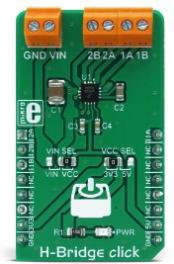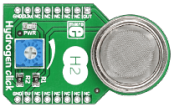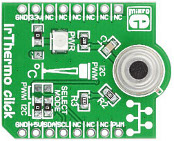Search
Search for "click":
(Click here to search this entire website for "click" with Google.)
 |

|
|
GSM/GNSS click combines GPS/GLONASS location tracking with GSM module capability for mobile communication. The click features Quectel's MC60 quad-band module. GSM/GNSS click runs on either 3.3V or 5V power supply and communicates with the target MCU over UART interface, and the following mikroBUS™ pins: AN, RST, PWM, INT. |
|
|
|
 |

|
|
H-Bridge click is a high-efficiency dual H-bridge driver Click board™, capable of providing reasonably high current while driving the connected load with up to 7V. Since the used driver IC has two full H-bridge channels, this Click board™ is an ideal solution for driving smaller bipolar stepper motors. H-Bridge click provides driving in both directions, with an addition of the brake mode, and the high impedance mode (Hi-Z). Overshoot current suppression algorithm protects the output stages from being damaged if both high-side and low-side MOSFETs on a single H-bridge channel become conductive. |
|
|
|
 |

|
|
Hydrogen click carries an MQ-8 sensor for hydrogen (H2). The gas sensing layer on the sensor unit is made of tin dioxide (SnO2), which has lower conductivity in clean air. The conductivity increases as the levels of hydrogen rise. The detection range of the sensor is 100-10000ppm of hydrogen. To calibrate the sensor for the environment you’ll be using it in, Hydrogen click has a small potentiometer that allows you to adjust the load resistance of the sensor circuit. For precise calibration the sensor needs to preheat (once powered up, it takes over 24h to reach the right temperature). Hydrogen click communicates with the target board through AN (OUT) mikroBUS line. It's designed to use a 5V power supply only. |
|
|
|
 |

|
|
IR Sense click carries the AK9750 quantum-type IR sensor. The click is designed to run on a 3.3V power supply. It communicates with the target microcontroller over I2C interface, with additional functionality provided by the INT pin on the mikroBUS™ line. |
|
|
|
 |

|
|
IrThermo Click features either the MLX90614ESF-BAA (3.3V) or MLX90614ESF-AAA (5V) single zone infrared thermometer module capable of non-contact temperature measurements. It is calibrated in wide temperature ranges: -40 to 85°C for the ambient temperature and -70 to +380°C for the object temperature (-20 to 120°C in PWM mode). IrThermo Click communicates with the microcontroller via mikroBUS I2C lines (SCL, SDA) or PWM line. The sensor is ideal for automotive use, industrial temperature control, body temperature measurement, movement detection, air conditioning control and more. |
|
|
|
 |

|
|
ISM RX 3 Click is a compact add-on board that contains a Sub-GHz RF receiver. This board features the MAX41470, a high-performance, low-power receiver ideal for amplitude shift-keyed (ASK) and frequency shift-keyed (FSK) data from Analog Devices. It can be configured for three sub-1GHz bands using an onboard 16MHz crystal: 287MHz to 320MHz, 425MHz to 480MHz, and 860MHz to 960MHz, fully programmable through an SPI interface. The receiver has excellent RF sensitivity and long-range, allows input signals up to 0dBm of power at the RF input, and features a fully programmable, self-polling (duty cycling) mode with preamble detection and interrupt output to wake up an external MCU. This Click board™ is suitable for cost- and power-sensitive applications, such as home automation and security, building access control, remote keyless entry, garage or gate doors control, and similar applications.
ISM RX 3 Click is supported by a mikroSDK compliant library, which includes functions that simplify software development. This Click board™ comes as a fully tested product, ready to be used on a system equipped with the mikroBUS™ socket.
|
|
|
|
 |

|
|
LCD mini click displays 2x16 monochrome characters on an LMB162XFW LCD display. It features the MCP23S17 port expander and the MCP4161 digital potentiometer, both from Microchip. LCD mini click is designed to run on either 3.3V or 5V power supply. It communicates with the target microcontroller over SPI interface and the following pins on the mikroBUS™ line: PWM, INT, RST, AN.
LCD purchased seperately. |
|
|
|
 |

|
|
LCD Mono Click is a Click board™ that uses the LS013B7DH03 LCD display from Sharp which combined with the EFM32, from Silicon Labs, and its energy saving capabilities creates a powerful display application. The application is capable of driving a 128x128 pixel display drawing as little as 2 µA while showing a static image. Even when updating the frame every second the current consumption can be lower than 5 µA.
LCD Mono click is supported by a mikroSDK compliant library, which includes functions that simplify software development. This Click board™ comes as a fully tested product, ready to be used on a system equipped with the mikroBUS™ socket.
|
|
|
|
 |

|
|
LED Ring click is a mikroBUS add-on board with a ring of 32 red LEDs driven by four 8-bit 74HC595 serial-in, parallel-out shift registers. The ring is 25mm in diameter. The click communicates with the target MCU through the mikroBUS SPI interface, with RST, CS, SCK, MISO and MOSI pins marked MR#, LAT, CLK, DSOUT, DSIN, respectively. The board is designed to use either a 3.3V or 5V power supply only. |
|
|
|
 |

|
|
LIN HALL click carries an MLX90242 linear Hall sensor IC (with built-in active error correction circuitry) and an MCP3201 12-bit ADC. It outputs a signal that is proportional to the flux density of a magnetic field - a north magnetic field will increase the output value while a south magnetic field will cause it to decrease. The ratiometric output allows you to infer the linear or rotary position of a target object by placing magnets on it. LIN HALL click communicates with the target board through the mikroBUS SPI lines (CS, CSK, MISO). The board is designed to use either a 3.3V or a 5V power supply. |
|
|
|
 |
|
<< First
< Previous
Next >
|
|

